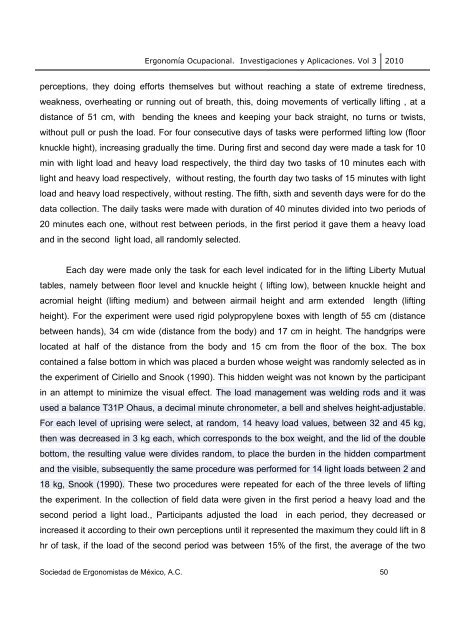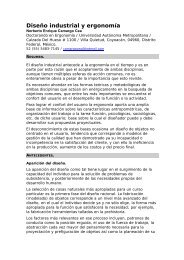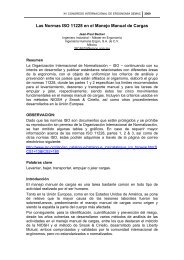ERGONOMÍA OCUPACIONAL - SOCIEDAD DE ERGONOMISTAS ...
ERGONOMÍA OCUPACIONAL - SOCIEDAD DE ERGONOMISTAS ...
ERGONOMÍA OCUPACIONAL - SOCIEDAD DE ERGONOMISTAS ...
You also want an ePaper? Increase the reach of your titles
YUMPU automatically turns print PDFs into web optimized ePapers that Google loves.
Ergonomía Ocupacional. Investigaciones y Aplicaciones. Vol 3 2010<br />
perceptions, they doing efforts themselves but without reaching a state of extreme tiredness,<br />
weakness, overheating or running out of breath, this, doing movements of vertically lifting , at a<br />
distance of 51 cm, with bending the knees and keeping your back straight, no turns or twists,<br />
without pull or push the load. For four consecutive days of tasks were performed lifting low (floor<br />
knuckle hight), increasing gradually the time. During first and second day were made a task for 10<br />
min with light load and heavy load respectively, the third day two tasks of 10 minutes each with<br />
light and heavy load respectively, without resting, the fourth day two tasks of 15 minutes with light<br />
load and heavy load respectively, without resting. The fifth, sixth and seventh days were for do the<br />
data collection. The daily tasks were made with duration of 40 minutes divided into two periods of<br />
20 minutes each one, without rest between periods, in the first period it gave them a heavy load<br />
and in the second light load, all randomly selected.<br />
Each day were made only the task for each level indicated for in the lifting Liberty Mutual<br />
tables, namely between floor level and knuckle height ( lifting low), between knuckle height and<br />
acromial height (lifting medium) and between airmail height and arm extended length (lifting<br />
height). For the experiment were used rigid polypropylene boxes with length of 55 cm (distance<br />
between hands), 34 cm wide (distance from the body) and 17 cm in height. The handgrips were<br />
located at half of the distance from the body and 15 cm from the floor of the box. The box<br />
contained a false bottom in which was placed a burden whose weight was randomly selected as in<br />
the experiment of Ciriello and Snook (1990). This hidden weight was not known by the participant<br />
in an attempt to minimize the visual effect. The load management was welding rods and it was<br />
used a balance T31P Ohaus, a decimal minute chronometer, a bell and shelves height-adjustable.<br />
For each level of uprising were select, at random, 14 heavy load values, between 32 and 45 kg,<br />
then was decreased in 3 kg each, which corresponds to the box weight, and the lid of the double<br />
bottom, the resulting value were divides random, to place the burden in the hidden compartment<br />
and the visible, subsequently the same procedure was performed for 14 light loads between 2 and<br />
18 kg, Snook (1990). These two procedures were repeated for each of the three levels of lifting<br />
the experiment. In the collection of field data were given in the first period a heavy load and the<br />
second period a light load., Participants adjusted the load in each period, they decreased or<br />
increased it according to their own perceptions until it represented the maximum they could lift in 8<br />
hr of task, if the load of the second period was between 15% of the first, the average of the two<br />
Sociedad de Ergonomistas de México, A.C. 50




